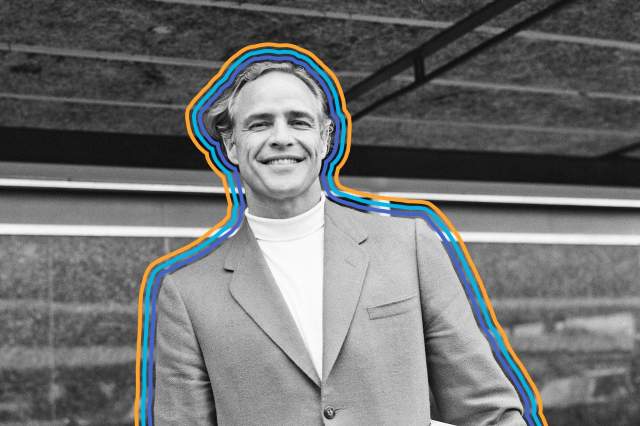
A Teenage Brando Was Expelled From Military School
The youngest child of a strict father and an alcoholic mother, and hamstrung by dyslexia, Brando acted out in school. According to Peter Manso’s biography, Brando orchestrated an endless series of pranks while accumulating just six of 15 possible credits over three years at Libertyville (Illinois) High School, forcing his dad to arrange a transfer to Minnesota’s Shattuck Military Academy. But the disruptions continued in Shattuck’s hallways, with Brando at one point hiding the dining room silverware before he was kicked out at the end of his second year. Amazingly, the cadets who were often the butt of his jokes threatened to boycott classes over what they felt was an unfair expulsion, and Brando later framed the letter of support they wrote to him.

He Nearly Blew the Opportunity for His Breakout Stage Role
After witnessing Brando’s impressive audition for A Streetcar Named Desire in August 1947, director Elia Kazan gave the magnetic young actor money to take a bus to Massachusetts for a further tryout with playwright Tennessee Williams. Brando instead spent the cash on party supplies, before hitchhiking his way to Massachusetts a week later. Upon reaching Williams’ home, Brando smoothed over any bad feelings about his late arrival by fixing a blown fuse and broken toilet. A quick read for the part sealed the deal, and Brando was on his way to revealing his preternatural talent to the world.

He Directed One Feature Film
Taking on an outsized role in the production of One-Eyed Jacks (1961), Brando drove out original helmer Stanley Kubrick and took over double duty as director and star of the Western. That worked out fine for his artistic sensibilities, but Brando’s habit of letting the camera endlessly roll as characters improvised their way through scenes took its toll on time and budget constraints. After viewing the costly, 4.5-hour director’s cut, producer Frank P. Rosenberg complained, “That’s not a picture. That’s just an assemblage of footage.” One-Eyed Jacks was whittled down to 141 minutes, and while the still-meandering final product has its admirers, the experience was apparently off-putting enough to discourage its star from returning to the director’s chair.
More Interesting Reads

Brando Owned an Atoll in French Polynesia
After frolicking in the tropical locale of Tahiti during the filming of Mutiny on the Bounty (1962), Brando decided to take a slice of paradise for himself by buying the nearby atoll of Tetiaroa in 1966. Although the initial plan was to build a hotel as part of what would become a self-sustaining community, Brando preferred using the property as a private retreat for himself, family, and friends, though he neglected to put in the time and money needed for its upkeep. He steered clear of Tetiaroa following a tragedy involving his son and a daughter’s boyfriend in the early 1990s, and a section of the atoll was leased to a developer after the actor’s death in 2004. That area now boasts the Brando Resort, the sort of exclusive vacation destination its namesake was reluctant to develop while still alive.

He Spontaneously Created Vito Corleone’s Persona During a Screen Test
Although Paramount Studio executives were loath to cast Brando in The Godfather (1972) following his string of poorly received films, director Francis Ford Coppola convinced them to at least consider a screen test. He subsequently brought a camera to Brando’s home, upon which the just-awakened host, realizing this was his audition, quickly slipped into his interpretation of Mafia boss Vito Corleone. Suggesting that Corleone should “look like a bulldog” and talk in a peculiar way, Brando stuffed tissues into his mouth and began acting out the character, even delivering that now-famous mumbling when answering a phone call. The once-leery execs were floored by the footage, paving the way for Brando’s highly celebrated comeback.

Brando Surprised Sacheen Littlefeather With His Plan for the 1973 Oscars
In one of the more infamous moments of his career, Brando sent actress and activist Sacheen Littlefeather to the 1973 Academy Awards to decline his Best Actor Oscar over “treatment of American Indians today by the film industry.” Littlefeather, who had struck up a friendship with the actor via their shared passion for Native American rights, reportedly wasn’t aware of the full scope of Brando’s plan until the afternoon of the Oscars telecast. She then waited as Brando worked on a lengthy speech, leaving her barely enough time to make it to the ceremony, and endured harassment in the parking lot before making it back to the safety of the actor’s home. According to Manso’s biography, Brando was happy with her effort, although he later noted that he’d “probably handle it differently” were he to do it all over again.

He Was Close Friends With Fellow Star Jack Nicholson
While Brando and Jack Nicholson made for a fun pairing in the 1976 Western The Missouri Breaks, the two were far closer than your typical co-stars. The actors shared a driveway as Los Angeles-area neighbors for about 30 years, and at one point even lived together while Nicholson was going through a divorce. Nicholson helped care for Brando toward the end of his life, after which he penned a heartfelt obituary in Rolling Stone magazine. He also purchased the late actor’s mansion with the hope of making it available to Brando’s children, but reportedly turned it into a garden when none of them showed any interest in the property.

Brando Received Four Patents for a Drum Tuner
An enthusiastic percussionist with an ear for Afro-Cuban music and an innovative mind, Brando devoted much of his final years to developing a new and improved conga drum. Collaborating with a custom drum parts maker and a patent attorney, Brando obtained four patents for his drum tuner, a single lever and linkage system designed to replace the five or six bolts normally used for the purpose. He even produced a few working prototypes, but was unable to get the design licensed before his passing.

More Than 300 Hours of Confessional Audio Tapes Were Found After His Death
Although Brando published an autobiography in 1994, that book provided only a partial reveal of a celebrity who increasingly shunned the spotlight. Additional insights arrived around 20 years later, when a production team gained access to more than 300 hours of audio footage of the actor waxing on his troubled upbringing, his own struggles as a father, his relationship with fame, and much more. Producers also found rudimentary 3D scans of Brando’s head, and used updated technology to match some of the audio with his animated, talking face. The result was the 2015 documentary Listen to Me Marlon, a life story narrated solely by the enigmatic star, between old film and interview clips, that marked one final posthumous screen performance.












